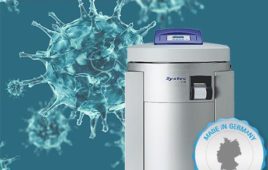Filters are one of the most critical components in a copper plating tool, ensuring low wafer defects by providing a particle-free plating solution. To maintain a low particle level in the plating solution, the filter must have very good particle retention. At the same time, it should also have a long lifetime to minimize the tool downtime associated with filter replacement. Therefore, an optimum filter for a copper plating system should be highly efficient in removing the type of particle generated during the plating process. In addition, the filter must be selected so that it doesn’t absorb or remove desirable components like additives as it removes contamination from the solution.
This paper describes a comparative study of efficiency and performance of symmetric versus asymmetric filter media in the removal of gel-like particles generated during a copper plating process. A unique method was developed to non-intrusively analyze the lifetime performance of several filter media in a real production tool non-intrusively rather than waiting for 2–3 months to evaluate a filter on a production tool at a willing customer site and then repeating the same process for the next filter. The final media selection was further evaluated for additive absorption and on wafer defect performance.

BACKGROUND
Copper plating tools deposit thin layers of copper in vials and on the wafersurface using an electrochemical process. A particle-free plating solution at the proper chemical formulation must be presented to the wafer under uniform pressure and flow to result in uniform copper plating on the entire surface of the wafer and from wafer to wafer. This is accomplished by recirculating large volumes of the plating solution past the surface of the wafer (Figure 1). It is important that the chemistry of the solution remains uniform during the copper plating process to ensure repeatable performance. To maintain a low particle level, the fluid is filtered in a recirculated mode at a high flow rate. The filter must have low pressure drop, good particle retention, and high throughput to result in low wafer defects and high system uptime. As with recirculated etch bath filtration, the particle retention of the filter must be balanced with high flow properties of the filter.1,2In general, it is most important to have high and consistent flow properties to maintainlow particle concentrations in the plating chemical.
One of the major problems in electrochemical copper deposition is the formation of particles as a result of the plating process. These particles can be gelatinous in nature and must be removed from the chemical to prevent contamination of the wafer surface. Unfortunately, the gel-like nature of these particles significantly increases their ability to plug the filters. It is not uncommon for the filter to become plugged in six weeks under heavy use conditions. As the filter becomes plugged, the flow decreases and particle performance suffers, requiring the tool to be taken down for maintenance. The purpose of this study was to find a particle filter for the recirculation loop that would have a lifetime of at least three months and provide low particle levels in the plating bath while having no impact to additive concentrations.


EVALUATION OF FILTRATION MEDIA
The first step in the process of increasing the filter lifetime was to analyze filters that were plugged after six weeks in the process equipment. The pressure drop of the filter was measured using water in a controlled test system. After six weeks, the pressure drop of the filter was 60% higher than that of a new filter. Soaking the filter in 10% sulfuric acid reduced the pressure drop by 9%, but not enough to consider sulfuric acid soaking as a regeneration process. Used filters were cut apart and samples of membrane were tested with more aggressive chemical cleaning solutions including 25% sulfuric acid or sulfuric acid/oxidizer combinations. Both were effective in restoring the flow of the membrane. These observations support the hypothesis thatthe plugging agents were organic in nature.
Figures 2 and 3 show scanning electron microscopy (SEM) and electron dispersive spectroscopy (EDS) images of the filter surface for used and new filters, respectively. In addition to the large gel particle, a comparison of new and used filters clearly shows gelatinous residue masking the pore structure of the membrane. The EDS identifies the elemental constituents of the particulate material as carbon, oxygen, and sulfur. The small platinum (Pt) peak is an artifact of the sample preparation. It is believed that the source of the particles isan electrochemical reaction with one of the plating bath additives.
Since the plugging material is a soft gel, there are two approaches to increasing filter lifetime.3The brute force approach is to increase filter area and spread the plugging agent over more surface. However, this technique generally requires a larger footprint for the filter housing and a system with more hold-up volume. The more elegant approach is to modify the structure of the filter so there are more places on the surface of the filter for particles to be trapped without blocking the pores. This technique uses an asymmetric membrane structure in which the upstream surface of the filter has larger pores than the downstream surface. Large particles are retained in such a way that they don’t completelyblock the pores. Figure 4 is a schematic representation of the way particles are retained on symmetric and asymmetric structures. Figure 5 shows the SEmicrographs of the cross-section of the symmetric and asymmetric filters.


Since the plugging agent is formed in the plating process and is not amenable to modeling with a stable test particle, the best method for evaluating potential membrane materials for plating bath filtration is to place a sample of the filter on a production bath. While there would be a risk in placing a developmental filter on a production tool, a novel approach was developed where a small sample of membrane is placed on a slipstream from the production tool. In this manner, several membrane samples can be tested simultaneously so that direct comparisons can be easily made. Since the pressure drop across the small membrane samples is greater than across the process tool filter, the evaluation of the test filters can be done in an accelerated mode. Figure 6 is a photograph of the sample filter holder and membrane and Figure 7 is a schematic of the flow path of the modified process tool. The membrane samples tested were 47-mm disks in holders with plastic wetted surfaces. The flow through each disk could be measured separately to determine any change in filter resistance. In addition, the effluent from each filter sample could be plumbed to an optical particle counter to measure the effectiveness of each membrane sample in removing particles.



Figure 8 is a summary of the evaluation of the symmetric and asymmetric filter samples. It shows the flow rate through the membrane and the pressure upstream of the membrane samples. During the first week of the test, the pressure increased slightly because the main circulation loop filter was plugging slightly. The main circulation loop filter was replaced between 9/26 and 10/4, lowering the feed pressure to the filters. During the first week, the symmetric filter lost about half of its flow. Over the two weeks of the test, the asymmetric filter had constant flow. Figure 9 shows a normalized flow in cc/min/psi. This method of flow analysis removes the effect of the change in pressure.
An optical particle counter capable of detecting particles larger than 0.2 µm was installed on the feed to the filter samples and on the effluent from the coupon samples. The particle levels were measured over time. Both the symmetric and asymmetric membrane coupons reduced the particle levels by a factor of greater than 200 (Figure 10). It is very difficult to achieve low particle counts downstream of the sample membrane holders, so the absolute particle level downstream of the filter coupon should not be considered the best the filter can do. The particle data demonstrates the particle retention equivalence of the asymmetric filter even though it has significantly higher throughput than the symmetric filter.


ADDITIVE ABSORPTION STUDIES
It is very important that the level of additives (accelerator, leveler, and suppressor) remain constant in the bath over time because some membrane filters may remove these components due to adsorption. This effect was evaluated by filtering 15 L of low acid copper plating solution through a 10-inch asymmetricfilter cartridge over a four-hour period. The concentration of each of the additives was measured using the CSV method. The CVS instrument has an error rating of 5%. Since the filter is new and the membrane area to solution volume is high, the sensitivity of this test was high. Figure 11 shows that there wasno loss of any of the additives.

PERFORMANCE OF ASYMMETRIC FILTER IN THE PLATING PROCESS
Table 1 is a comparison of the attributes of the commercial 10-inch filters available with the membrane samples tested. The filters have essentially the same pore size and particle retention. The symmetric filter was designed to be used in recirculated etch baths where the multiple pass mode of operationresults in better effective particle retention. Based on the flow through the 47-mm coupons, the resistance to flow of both samples is about the same. The rated pressure drop of the symmetric filter is about 70% that of the asymmetric filter. This is due in part to the larger membrane area of the symmetric filter cartridge. The increased pressure drop of the asymmetric filter is small enough that it will not be significant in the application. Both filters have low enough pressure drops that the flow losses in piping and fittings will dominate and both the symmetric and asymmetric filterswill have the same flow in the tool.
Since laboratory testing showed the asymmetric filter to be promising, a marathon test was run in the laboratory. A new asymmetric filter was installed in Cell2 of Bay 1 of the process tool and new symmetric filters were installed in Cells1 and 3. Monitor tests were done at wafer 0 (T0), 200(T1), 1700(T2), 2750(T3),and 3500(T4).
The additive level was measured over four hours using CVS analysis with ViaForm NExT additive analysis protocols. Table 2 shows no change in the additive levels,indicating no binding or leaching.


The effect of pump rpm on pump flow ratewas measured for each of the filters initially and after four hours of testing. The curves (Figure 12) indicate that the asymmetric and symmetric filter have virtually the same flow characteristicsin the application. The rpm of the pumps remained constant throughout the marathon.
After analyzing the defects on the wafers, no difference was found between the test filter and the process of reference. The defects were slightly elevated, but it was found to be unrelated to the filter testing. The fill rate was consistentthroughout the test for both cells and the additive levels were also consistent.
The range for both cells was less than 1000 Å when measured at a thickness of 3.5 mm. The uniformity (Figure 13) was less than 1.75%, when measured at 5.0 mm, and there were no differences in copper thickness or uniformity profile for the cell with the test filter and the cell with the POR. Figure 14 showsthat the fill rate was consistent throughout the marathon testing.



CONCLUSIONS
A systematic approach was used to solve a filter lifetime issue that was impacting the critical parameter of tool utilization. The initial step in this process was to identify the type of particle that was plugging the filter. The next step was to theorize a solution to this problem using membrane configuration and surface modification. A unique test methodology was developed to evaluate potential solutions to this filter lifetime issue that provided quicker results than the standard testing protocol. This testing proved the benefits of an asymmetric membrane configuration when dealing with solutions containing gelatinous particles. Testing indicates that the asymmetric filter has twice the throughput of the symmetric filter. The filter lifetime can be increasedfrom six weeks to three months, increasing the uptime of the tool.
Further testing was performed to refine the filter selection. This testing included absorption studies and flow studies. Based around the results of this testing, a final filter configuration was obtained that will provide the best results for this process. Additionally, the tool data is being collected to prove the benefits of the filter developed for this application.
References
- J. Zahka, D. Grant, and C. Myhaver, Modeling of particle removal from a circulating etch bath, Particles and Gases in Liquids 2, Plenum Press, NY, 1990.
- J Zahka, V. Anantharaman, M. Carroll, and K. Vakhshoori, Characterization of filters used in recirculated buffered oxide etch baths, Solid State Technology, 36(6):63-71, 1993.
- M Clarke and J Zahka, Understanding Membrane Plugging Mechanisms, Entegris Applications Note MAL 116,http://www.mykrolis.com/publications.nsf/20ff0e4cee05dc1985256c760051beef/ddb4e8136f05b0bf85256c4800744ca4?Open-Document.
Aiwen Wu is a Senior Applications Development Engineer and
Gregg Conner is an Applications Development Manager in Liquid Microcontamination Control at Entegris,Inc,129 Concord Road,Bil-lerica,MA 01821. Aiwen can be reached at [email protected]. Greg can be reached at [email protected].
Vinay Prabhakar is an Applications Engineer at Novellus Systems, Inc,11155 SW Leveton Drive,Tualatin,OR 97062 and can be reached at [email protected].



